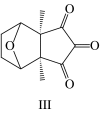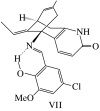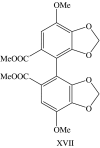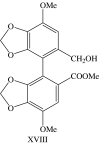Biological screening of natural products and drug innovation in China
- PMID: 17317643
- PMCID: PMC2435573
- DOI: 10.1098/rstb.2007.2036
Biological screening of natural products and drug innovation in China
Abstract
Natural products have been applied to human healthcare for thousands of years. Drug discovery in ancient times was largely by chance and based on clinical practices. As understanding of therapeutic benefits deepens and demands for natural products increase, previously serendipitous discoveries evolve into active searches for new medicines. Many drugs presently prescribed by physicians are either directly isolated from plants or are artificially modified versions of natural products. Scientists are looking for lead compounds with specific structures and pharmacological effects often from natural sources. Experiences and successes of Chinese scientists in this specialized area have resulted in a number of widely used drugs. The tremendous progress made in life sciences has not only revealed many pathological processes of diseases, but also led to the establishment of various molecular and cellular bioassays in conjunction with high-throughput technologies. This is advantageous and permits certain natural compounds that are difficult to isolate and purify, and compounds that are difficult to synthesize, to be assayed. The transition from traditional to empirical and to molecular screening will certainly increase the probability of discovering new leads and drug candidates from natural products.
Figures
















Similar articles
-
Natural products as starting points for future anti-malarial therapies: going back to our roots?Malar J. 2011 Mar 15;10 Suppl 1(Suppl 1):S3. doi: 10.1186/1475-2875-10-S1-S3. Malar J. 2011. PMID: 21411014 Free PMC article. Review.
-
The strategies and techniques of drug discovery from natural products.Pharmacol Ther. 2020 Dec;216:107686. doi: 10.1016/j.pharmthera.2020.107686. Epub 2020 Sep 19. Pharmacol Ther. 2020. PMID: 32961262 Review.
-
Japan-China Joint Medical Workshop on Drug Discoveries and Therapeutics 2008: The need of Asian pharmaceutical researchers' cooperation.Drug Discov Ther. 2008 Oct;2(5):262-3. Drug Discov Ther. 2008. PMID: 22504718
-
Natural products as leads to anticancer drugs.Clin Transl Oncol. 2007 Dec;9(12):767-76. doi: 10.1007/s12094-007-0138-9. Clin Transl Oncol. 2007. PMID: 18158980 Review.
-
Natural products for the treatment of stress-induced depression: Pharmacology, mechanism and traditional use.J Ethnopharmacol. 2022 Mar 1;285:114692. doi: 10.1016/j.jep.2021.114692. Epub 2021 Nov 3. J Ethnopharmacol. 2022. PMID: 34742864 Review.
Cited by
-
Susceptibility of Selected Multi-Drug Resistant Clinical Isolates to Leaves of Carpolobia lutea.Ethiop J Health Sci. 2018 Mar;28(2):117-124. doi: 10.4314/ejhs.v28i2.3. Ethiop J Health Sci. 2018. PMID: 29983509 Free PMC article.
-
Efficient Biosynthesis of Gastrodin by UDP-Glycosyltransferase from Rauvolfia serpentina.J Microbiol Biotechnol. 2025 Mar 26;35:e2501002. doi: 10.4014/jmb.2501.01002. J Microbiol Biotechnol. 2025. PMID: 40147927 Free PMC article.
-
A comparison of the cytotoxic potential of standardized aqueous and ethanolic extracts of a polyherbal mixture comprised of Nigella sativa (seeds), Hemidesmus indicus (roots) and Smilax glabra (rhizome).Pharmacognosy Res. 2010 Nov;2(6):335-42. doi: 10.4103/0974-8490.75451. Pharmacognosy Res. 2010. PMID: 21713135 Free PMC article.
-
Natural products for the treatment of trachoma and Chlamydia trachomatis.Molecules. 2015 Mar 5;20(3):4180-203. doi: 10.3390/molecules20034180. Molecules. 2015. PMID: 25751782 Free PMC article. Review.
-
TCMID: Traditional Chinese Medicine integrative database for herb molecular mechanism analysis.Nucleic Acids Res. 2013 Jan;41(Database issue):D1089-95. doi: 10.1093/nar/gks1100. Epub 2012 Nov 29. Nucleic Acids Res. 2013. PMID: 23203875 Free PMC article.
References
-
- A J.Y, Wang G.J, Liu X.Q, Jiang D.Y, Liu J.H. Study on the metabolite of guanfu base A hydrochloride in rat urine by high performance liquid chromatograph–mass spectrum. Acta Pharmacol. Sin. 2002;37:283–287. - PubMed
-
- A J.Y, Wang G.J, Sun J.G, Gu Y.C, Wu M.S, Liu J.H. Identification of phase I and phase II metabolites of guanfu base A hydrochloride in human urine. Eur. J. Drug Metab. Pharmacokinet. 2003;28:265–272. - PubMed
-
- Birdsall T.C, Kelly G.S. Berberine: therapeutic potential of an alkaloid found in several medicinal plants. Altern. Med. Rev. 1997;2:94–103.
-
- Braquet P.G. Bn-52021 and related compounds: a new series of highly specific PAF-acether receptor antagonists. Int. J. Immunopharmacol. 1985;7:384. doi:10.1016/0192-0561(85)90411-4 - DOI
-
- Brossi A, Venugopalan B, Gerpe L.D, Yeh H.J.C, Flippen-Anderson J.L, Buchs P, Luo X.D, Milhous W, Peters W. Arteether, a new antimalarial drug: synthesis and antimalarial properties. J. Med. Chem. 1988;31:645–650. doi:10.1021/jm00398a026 - DOI - PubMed
Publication types
MeSH terms
Substances
LinkOut - more resources
Full Text Sources
Other Literature Sources
Research Materials

